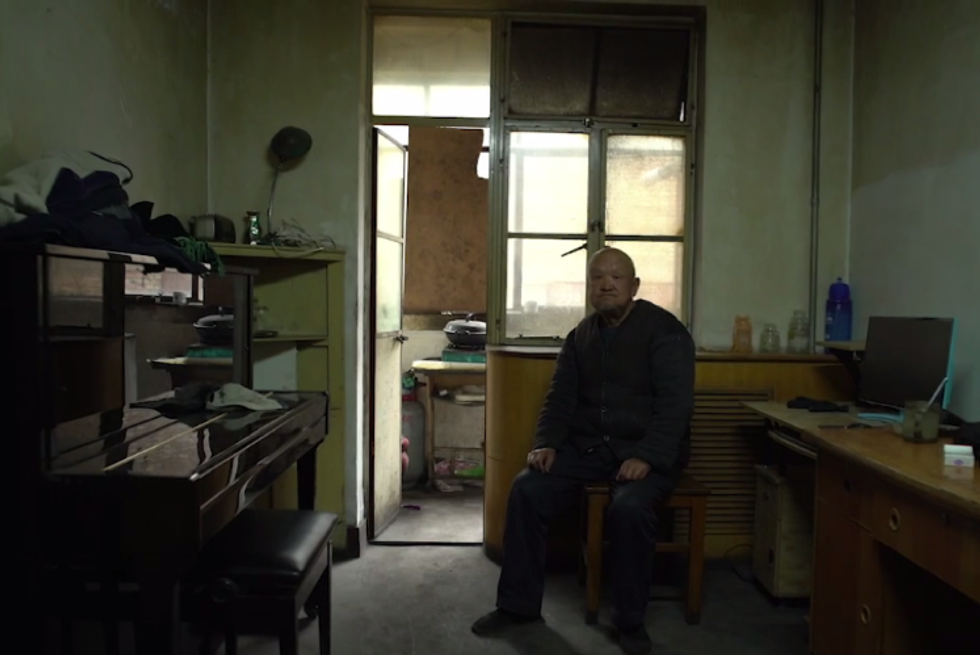
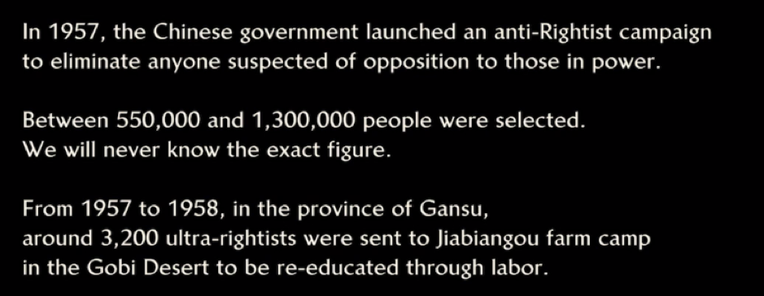
Dead Souls (2018) begins with this still. It is all the context that the documentarist, Wang Bing, provides for the viewer. Then, for almost eight hours, survivors and eyewitnesses speak. It is exclusively through direct accounts that we learn the history of the Jiabiangou reeducation camp and the vicissitudes of the inmates’ lives, each interview adding a new facet or a slightly different perspective. Some survivors explain the often arbitrary circumstances that led to their imprisonment or narrate the lengthy and absurd interrogations in which they were forced to confess nonexistent crimes. Interviewees have different professions, stories, and backgrounds, but two themes recur again and again: the experience of hunger, and that of death. Both were constant presences in the camp; of the 3,200 so-called rightists sent to Jiabiangou, only 500 survived.
The visceral experience of hunger is articulated by first-person accounts in a way that no indirect description could render as vividly: survivors speak of being reduced to voracious beings whose only aim and purpose was securing food for survival. "An extra bowl of food could save someone's life," one explains. "One bowl less could kill." Laborers physically became the search for food: bony, bloated, with cutlery and a basin carried around at all times to receive their daily ration. In an unsustainable economy, crops were planted during the day and then undug and devoured at night. The inedible became edible, debasing humans not even to animals, but to inhuman beings. All became food: an unwashed lamb's placenta, leaves, paper, and, finally, corpses.
The treatment of the dead is also described as inhuman: rituals deteriorated with the psychological and physical state of the living, who became increasingly apathetic and indifferent to death (even their own). Again, it is the details in the recorded accounts that depict the reality of life and death in Jiabiangou, each revealing a new form of degradation, another cultural rule infringed. First, the dead were buried in coffins, then in blankets tied with ropes. Bodies were abandoned or shallowly interred, the wind uncovering them immediately. Stones with names written on them were placed by the burial site, doomed to become illegible. Today, families look for gravesites but cannot find them.
Dead Souls was shot between 2005 and 2017, and the film is divided into three parts of more than two hours each. Wang Bing’s presence is invisible, unobtrusive to the point that we only fully see him during an interview in the third part. The documentary begins in an interior space, with a man in his eighties sitting in his home, telling his story. This is the scenic arrangement for the majority of the documentary. People speak at length, Wang Bing's questions are few, and silences are left uninterrupted. There is no music, no commentary—only captions with the names of survivors and locations. The camera continues to linger on the interviewees even when they are quiet. There is no constant zooming or close-ups of faces, eyes, and hands (by now a convention in the documentary genre). The interviewees are simply captured in their homes, speaking in their own rhythm.
The site of the Mingshui camp, part of the larger Jiabiangou camp, is not shown until the end of the first section. By that time, the viewer has heard several stories about the camp. Just as a survivor finishes describing the physical build of someone who died, the scene changes to a desert area with mountains on the horizon. The camera pans toward the ground: suddenly there are human bones. The lens remains glued to the ground as the cameraman walks. More bones: a femur, a vertebra, and a sacrum. These are the dead that we have heard of all along—those who did not make it. Scattered, omnipresent, resurfacing or never buried.
The first two parts of the documentary are similar in content and structure. Most interviewees speak profusely, at length, and are surrounded by tokens of a life that began again after Jiabiangou (homes, jobs, relatives, the noise of children in the background). The interviewees also have explanations for their survival: a divine miracle, strength of will, or having secured access to food, either by stealing, kitchen work, or supplies brought by family members. The randomness of survival, sometimes discussed in accounts of concentration camp survivors, is not prominent here although many do note that the dead being buried could have been them on the following day. Instead, questions arise about the deaths of those who did not make it. If explanations of personal survival emphasize agency and the deaths of others are explained mostly in terms of starvation and/or disease, were the dead then not adequately skilled as thieves? Could they not rely on ties of kinship strong enough to sustain them throughout their imprisonment? And what about those who could never begin a new and adjusted life after the time in Jiabiangou? These questions are partially addressed in the third and last part.
Here, for the first time, an interviewee speaks with irritation and bitterness. He is confrontational. He says that nobody wants to talk about that time anymore. His wife left him for another man while he was in the labor camp; the children in the pictures are not his own. He has lived all his life “like this” since his return. The camera moves to an alcohol bottle. The man hides it from view.
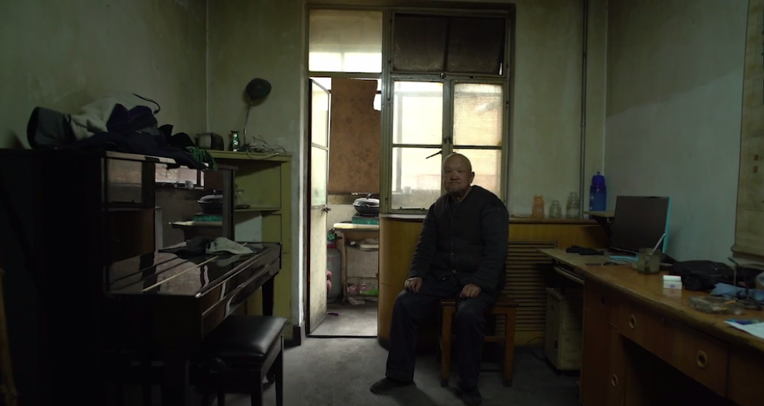
The voices of the dead are also present in the film: we are shown photos and letters written by Pei Zifeng, who died at forty-four in Mingshui. An initial message describes the camp in rosy hues (perhaps because of censorship or not to burden the family), while in the last one Pei Zifeng begs his relatives to send food, writing that even a morsel put aside by each might be enough to save him. We also learn about the wife of another prisoner: how the food that she sent never arrived.
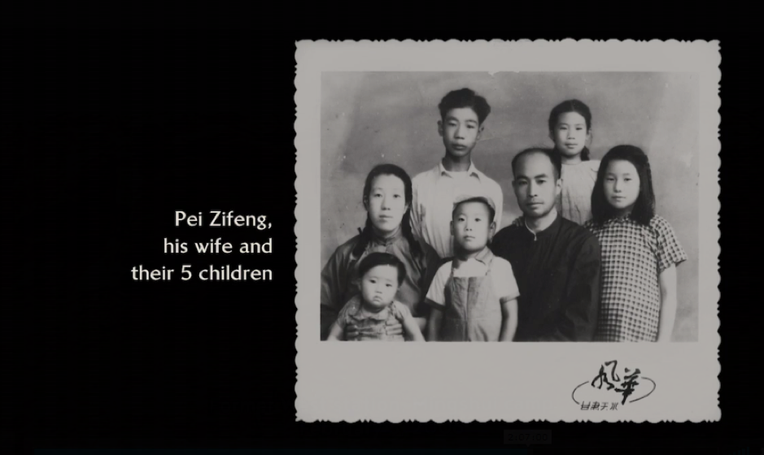
The documentary concludes with a ten-minute sequence of the rocky ground of Mingshui, as scattered human remains emerge from sand and ditches. Only the noise of the wind, footsteps, and distant sounds are audible.
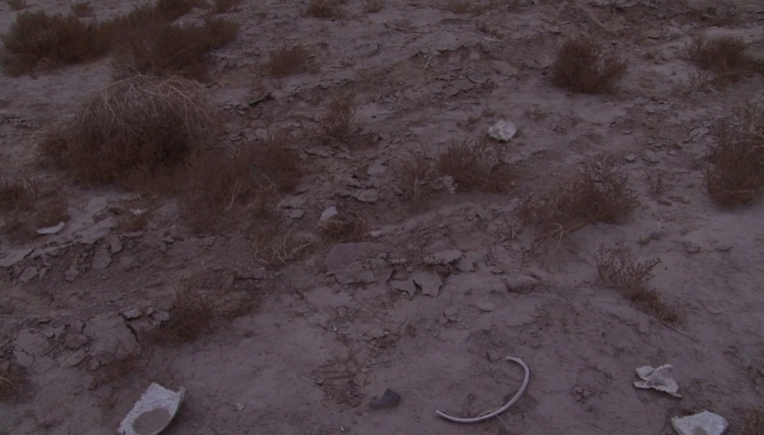
Wang Bing's choice to narrate political violence not through linear historical reconstruction but through uncommented direct accounts serves at once to educate and memorialize. His role is that of a respectful bringer of awareness: not a historian discovering something unknown to most, but a documentarist giving his interviewees a platform to publicly discuss a still uncomfortable political chapter. "Your pain has woken the sleeping souls of the deceased," writes Wang Bing at the end of each part, "so that all the hardships endured be known to as many people as possible."

At the same time, the documentary is a visual memorial to these victims of political violence, and one that is likely to endure in its reliance on the figure of the witness. Unlike cold stone and formulaic inscriptions that rapidly fall into indifference and forgetfulness, personal accounts, with their vivid, visceral, and unfiltered details, become an incisive and affective/effective means to force viewers to engage, relate, and confront—regardless of how alien or distant China's political and historical circumstances might be to their own. From this perspective, the very length of the film seems to imply that the real history of Jiabiangou—what must be conveyed about it—is not to be found in a tidy overview comprising timelines and death tolls, but in stories and experiences that must be given time to unfold. The experiences narrated here cannot be summarized.